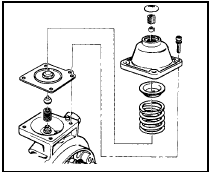Fuel pressure regulator - removal and refitting
Removal
1 Remove the CFI unit as described in Section 8.
2 Remove the four screws securing the regulator housing to the CFI unit, then carefully lift off the housing and recover the ball, cup, large spring, diaphragm, valve, and small spring, noting the position and orientation of all components (see illustration).

9.2 Exploded view of fuel pressure regulator - 1.4 CFI engine
Do not attempt to prise the plug from the regulator housing, or adjust the Allen screw (if no plug is fitted); this will alter the fuel system pressure.
3 Examine all components and renew any
defective items as necessary
Refitting
4 Commence reassembly by supporting the
CFI unit on its side so that the regulator
components can be fitted from above.
5 Fit the small spring, valve, diaphragm (ensuring that it locates correctly), large spring, and the spring cup.
6 Carefully place the ball into position on the spring cup, and ensure that it locates correctly.
7 Refit the regulator housing, taking great care to avoid disturbing the ball, and once correctly in position, tighten the screws evenly to avoid distorting the diaphragm.
8 Refit the CFI unit as described in Section 8.
9 On completion, the fuel system pressure should be checked by a Ford dealer at the earliest opportunity.
See also:
Engine/automatic transmission assembly - removal and separation
Note: A suitable hoist and lifting tackle will be
required for this operation. Any suspected
faults in the automatic transmission should be
referred to a Ford dealer or automatic
transmission spec ...
Carburettor (Pierburg 2V type) - fast idle speed adjustment
1 Check the idle speed and mixture
adjustment. The idle speed must be correct
before attempting to check or adjust the fast
idle speed.
2 With the engine at normal operating
temperature, and a ta ...
Crankshaft front oil seal - renewal
Note: A new gasket will be required for
refitting if the old seal housing is removed
during this procedure.
1 Remove the timing belt and the crankshaft
sprocket.
2 If an oil seal removal tool is ...
